Phase One of a Three-Phase Analysis
Special Thanks
Special thanks to Daniel Griner, Arianne Collopy, and Kelsie Faulds with University of Colorado Denver’s Inworks for their work to review the economic analysis methodology and findings of this report. Their insights were valuable in ensuring the study appropriately estimated the economic footprint of homelessness.
About the Mike A. Leprino Free Enterprise Fellowship
The Mike A. Leprino Free Enterprise Fellowship was established by Laura Leprino and Matthew Leprino in honor of the late Mike A. Leprino, who was a pillar in the Denver community. The son of Italian immigrants, he was a banker, developer and community servant. Some of the greatest treasures and neighborhoods in our state were built and funded by Mike. He gave back relentlessly to his state and country, something that he also instilled in each of his children. No greater defender of free enterprise and the American dream, Mike is someone who from humble beginnings built an enviable legacy in Colorado. Thanks to Mike A. Leprino’s legacy, we can all take a lesson in hard work, the entrepreneurial spirit, and the power of free enterprise. The Mike A. Leprino Fellowship will focus on issues reflected in the values and accomplishments of this former pillar of the community.
About the Authors
2021 Mike A. Leprino Free Enterprise Fellow
Brenda Bautsch Dickhoner, Ph.D. has spent the last decade working in education policy at the national and state level. Most recently, at the Colorado Department of Education, she developed and implemented policies to ensure all students have access to a high-quality education. Prior to CDE, Brenda served as an expert for the Colorado Department of Higher Education on research and policy related to college access and success. She began her career at the National Conference of State Legislatures where she advised state legislators in numerous states on education policy.
Brenda earned a Ph.D. in Public Policy at the University of Colorado Denver School of Public Affairs and studied political science as an undergraduate at Duke University.
Lili Valis graduated from the University of Colorado Boulder in 2019 with a B.A. in Political Science and a minor in Business Administration. She moved to Washington, D.C. after graduation where she worked in business development. After coming back to Denver, she joined Common Sense Institute as a Research Analyst before she will join the United States Air Force through the Officer Training program in September 2021.
About Common Sense Institute
Common Sense Institute is a non-partisan research organization dedicated to the protection and promotion of Colorado’s economy. CSI is at the forefront of important discussions concerning the future of free enterprise in Colorado and aims to have an impact on the issues that matter most to Coloradans.
CSI’s mission is to examine the fiscal impacts of policies, initiatives, and proposed laws so that Coloradans are educated and informed on issues impacting their lives. CSI employs rigorous research techniques and dynamic modeling to evaluate the potential impact of these measures on the Colorado economy and individual opportunity.
Common Sense Institute was founded in 2010 originally as Common Sense Policy Roundtable. CSI’s founders were a concerned group of business and community leaders who observed that divisive partisanship was overwhelming policymaking and believed that sound economic analysis could help Coloradans make fact-based and common sense decisions.
Introduction
Homelessness remains a pressing issue for the Metro Denver region. COVID-19 increased the visibility of the issue with shelters closing due the pandemic and greater numbers of individuals experiencing homelessness outdoors. Data indicates that the longer people are unsheltered, the more challenging rehousing becomes.[i] Strategies to improve early intervention, rapid rehousing, and permanent supportive housing are the path forward, as they mitigate the risks to the individual and society of long-term homelessness. Such strategies must also involve wraparound services to help some individuals overcome substance abuse, mental illness, and other trauma. The complexity of the ecosystem surrounding homelessness and the scarcity of affordable housing in the region makes implementing these strategies immensely difficult.
Common Sense Institute (CSI) has partnered with several local organizations and leaders to conduct a three-phase project to understand the many challenges and types of homelessness. Through a multi-faceted approach, CSI and its partners hope to identify the systemic issues that contribute to a person’s experience with homelessness and find the network of people and organizations working to make change. Bringing clarity and identifying the leverage points in these systems will support all who seek to tackle this challenge by providing critical information about where to invest their time, energy, and money to address the homelessness crisis.
Project Overview
Phase 1: Common Sense Institute has partnered with CU Denver, the Downtown Denver Partnership, Together Denver and other local associations and business leaders to conduct an economic analysis of the organizations serving individuals experiencing homelessness within the city of Denver and the broader seven-county Metro Denver region. The initial phase of the project includes the compilation of current resources dedicated to the various parts of the homelessness ecosystem for the purpose of understanding the economic footprint.
Phase 2: In the second phase of the project, CSI is partnering with CU Denver to engage with the local community and chart drivers and outcomes. We will capture and map the ways in which each organization impacts various system dynamics. In addition to providing clarity around the roles of organizations in the ecosystem, this model will also reveal which factors have outsized impacts and will provide insights into where additional interventions and investments might address the root causes of persistent problems and accelerate the positive dynamics within the system. Through this analysis, CSI and CU Denver will deliver a prioritized set of recommendations with the goal of maximizing total impact.
Phase 3: CSI and its partners also plan to launch a third phase focused on building a dynamic online data dashboard that provides data and projections regarding the current and future state of homelessness. This dashboard can serve as a continual touchpoint as the environment changes and will highlight specific areas of needed focus as they emerge.
This report represents the culmination of the work conducted during Phase 1 of this project. It is anticipated that Phase 2 and 3 will be released in the early fall of 2021. This report contains several parts: 1) a summary of data on homelessness in the Metro Denver region; 2) a look at revenue streams that support homelessness assistance programs; 3) a summary of estimated expenditures spent annually on shelters, services, emergency response and healthcare for individuals experiencing homelessness; 4) a look at the workforce and volunteer sector in this ecosystem; and 5) a summary of data on the availability and utilization of shelter beds.
Key Findings – Phase 1
Homelessness in Metro Denver
- The 2020 Point in Time (PIT) count, which provides a snapshot of the population experiencing homelessness in the region, counted 6,104 people experiencing homelessness on Jan. 27, 2020 in Metro Denver (covering the counties of Adams, Arapahoe, Boulder, Broomfield, Denver, Douglas and Jefferson). 4,171 of those individuals were living within the boundaries of the city and county of Denver, representing 68% of the region total.[ii]
- The city of Denver saw a 25 percent increase in its homeless population between January 2017 and January 2020, and a greater increase is expected to be seen because of the devastating impacts of the COVID-19 pandemic.
- Due to COVID-19, the 2021 PIT count was not conducted, leaving an unclear picture of how the pandemic has affected the homeless population overall. City of Denver data does show that there was a 46% increase in the number of guests at emergency shelters from January 2020 to January 2021.[iii]
- Nearly a quarter of people experiencing homelessness in Metro Denver are families with children under 18 (420 families comprising a total of 1,446 individuals).[iv]
- 10 percent of the homeless population in Metro Denver are veterans. [v]
- In Metro Denver, 30 percent of individuals experiencing homelessness have a substance abuse concern and 36 percent have a mental health concern.
- Of those counted in the PIT survey, 22% were newly homeless and 30% were chronically homeless.[vi]
Revenue Streams: Homelessness Assistance Programs
- The homelessness ecosystem consists of a complex array of organizations, agencies, and funding streams. The U.S. Department of Housing and Urban Development (HUD) is the key federal agency working on this issue, while states and localities have many different agencies and departments working on preventing and resolving homelessness.
- In FY 2020, HUD spent $2.777 billion on homelessness assistance programs across the country. Of that amount, Colorado received a total of $98.3 million across three programs that provide significant support to people experiencing homelessness: the Continuum of Care (COC) program, the Emergency Solutions Grant (ESG) and the Housing Trust Fund (HTF).
- The CARES Act COVID-19 federal relief package allocated $55.4M to the ESG program in 2020; the amount without the CARES Act funding for 2020 would have been $42.9 million.
- The 2021 American Rescue Plan provided $29.4 million cities and counties in Metro Denver for the HOME Investment Partnerships Program. According to HUD, these funds are intended to “help communities across the country create affordable housing and services for people experiencing or at risk of experiencing homelessness.” [vii]
- The state has proposed it will use $550 million in state funds received from ARPA for the purpose of affordable housing. It is expected that some portion of this will go towards supporting people experiencing homelessness.
- Lastly, the state-funded Colorado Rescue Plan allocates $15 million to hotel rooms for unhoused individuals and $13 million in affordable housing projects incentives.[viii]
Estimated Expenditures: Homelessness Assistance Programs
- Within the Metro Denver region, at least $481.2 million is spent annually on shelters, services, emergency response and healthcare for individuals experiencing homelessness.
- In comparison, Colorado spends $324.5 million on the statewide budget of the Department of Public Safety.
- Out of the total estimate of $481.2 million, approximately $434 million is spent within the City of Denver, while approximately $15.9 million is spent with the City of Boulder and approximately $7.8 million is spent within the City of Aurora.
- For a population ranging from 4,171 to 10,428, these expenditures equate to a range of $41,679 per person to $104,201 per individual experiencing homelessness in the City of Denver.
- In comparison, the per-pupil spending in K-12 schools in Denver Public Schools in 2019 was $19,202 for a total school population of 87,644.
- The estimated expenditure amount of $481.2 million does not represent the full array of charitable organizations, public agencies, or health care and emergency response systems that are dedicated to serving individuals experiencing homelessness.
- This analysis of annual expenditures includes only a partial list of municipal agencies engaged on this issue within Denver, Boulder or Aurora, and it does not include any city or county agencies in other areas of Metro Denver.
- Although Denver Health costs are included, other regional and local hospital and health care costs are not included. For example, facilities at the UCHealth Anschutz Medical Campus provide a significant amount of uncompensated care to people experiencing homeless in Aurora and surrounding communities.[ix]
- The estimated $481.2 million in expenditures likely capture some revenues flowing from the 2020 Cares Act to organizations in the Metro Denver region, given this report focused on FY 2020 expenditures from charitable organizations. The $481.2 million amount, however, does not include COVID-19 federal stimulus funding from the American Rescue Plan Act (ARPA), which was enacted in March 2021 and provided $29.4 million for the HOME Investment Partnerships Program. Additionally, the state has proposed to use $550 million of the $3.8 billion in state funds received from ARPA for the purpose of affordable housing.[x] It is expected that some portion of this will go towards supporting people experiencing homelessness. Colorado has also put state funds toward the Colorado Rescue Plan, under which $15 million has been allocated to purchasing hotel rooms for unhoused individuals and $13 million is allocated for affordable housing project incentives.[xi]
Workforce Serving People Experiencing Homelessness
- In Metro Denver, it is estimated that 4,000–7,000 employees work in organizations, government agencies, emergency response units or other entities that have services or housing dedicated to people experiencing homelessness.
- The estimated number of volunteers ranges from 55,000 to 85,000 people putting in around 200,000–300,000 hours.
- The estimated financial value of volunteer hours is $5.7–$8.6 million.
Number of Beds and Units for People Experiencing Homelessness
- Over the past 10 years, the number of permanent supportive housing beds and emergency shelter beds have increased, while the number of transitional housing and rapid rehousing beds have decreased.
- Overall, both transitional housing and emergency shelters in Metro Denver had beds available during the 2020 Point in Time count. Transitional housing was 72 percent occupied and emergencies shelters were 82% occupied if including the severe weather beds, or 88% occupied if severe weather beds are excluded.[xii]
- Data on bed occupancy for permanent supportive housing is not available for 2020, but in 2019, there 98 percent of permanent supportive housing beds were occupied during the PIT count.[xiii]
- A portion of the available emergency shelter beds are for severe weather use only. During extreme weather and emergencies, the City of Denver adapts to accommodate people experiencing homelessness. As a city that experiences both extreme cold conditions in the winter and hot in the summer, Denver has elasticity in the number of shelter beds available.
- Additionally, Denver increased the number of shelter beds during the onset of the pandemic in spring 2020. The concerted effort to expand the availability of beds meant that supply kept pace with, and even, exceeded demand as the number of people experiencing homelessness increased during COVID-19.[xiv]
Homelessness in Metro Denver
The Metro Denver Homeless Initiative (MDHI) conducted a Point in Time (PIT) count on January 27, 2020, to assess the number of individuals experiencing homelessness on that night. The count is conducted annually to assess the scope of homelessness and to provide information to the U.S. Department of Housing and Urban Development (HUD) for programmatic funding. In the seven-county Metro Denver region, 6,104 individuals were experiencing homelessness in January 2020.[xv] Sixty eight percent of these individuals were in the city and county of Denver (see Figure 1).
Figure 1: Metro Denver Point in Time Count, 2020
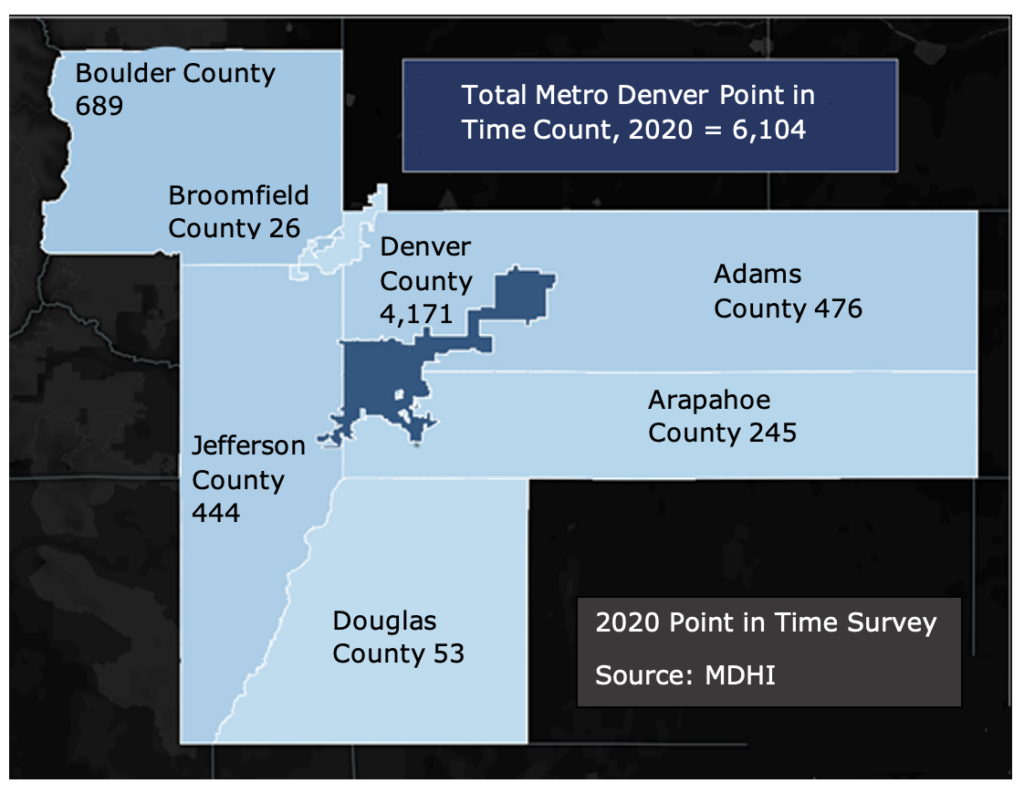
In Denver, 4,171 people were identified as experiencing homelessness during the January 2020 count. The count has been on an upward trend since 2017, with the number of individuals experiencing homelessness increasing by 25 percent since that year (see Figure 2).[xvi] A greater increase in homelessness is expected because of the devastating impacts of the COVID-19 pandemic. Due to COVID-19, the 2021 PIT count was conducted for housed individuals only, leaving an unclear picture of how the pandemic has affected the homeless population overall. City of Denver data does show that there was a 46% increase in the number of guests at emergency shelters from January 2020 to January 2021.[xvii]
Figure 2: Homeless Population Numbers Over Time, PIT Counts

Source: U.S. Department of Housing and Urban Development
The 2020 Point in Time count also captured data on other individual characteristics and on where everyone slept the night before. Across the Metro Denver region, 48 percent of individuals experiencing homelessness were in emergency shelters (n=2,911), while 26 percent were unsheltered (n=1,632), and 26 percent were in transitional housing (1,561). Denver’s distribution mirrors the regional data. (See the glossary in the appendix for definitions of different housing circumstances.)
Figure 3: Where People Experiencing Homelessness Stayed in Metro Denver, 2020

Source: MDHI, 2020 PIT.
Note: Transitional housing includes safe havens.
Figure 4: Population Experiencing Homeless in Metro Denver, 2020

Source: MDHI, 2020 PIT
*420 families comprised of 1,446 individuals makes up 24% of the total PIT count
Additionally, nearly 10 percent of the homeless population in Metro Denver are veterans (see Figure 4). Nearly a quarter of people experiencing homelessness in Metro Denver are families with children under 18 (420 families comprising a total of 1,446 individuals).[xviii]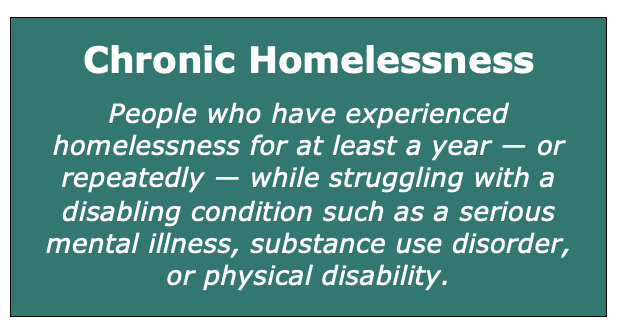
Thirty percent of the population counted in the Metro Denver region met the definition of chronically homeless, while 22 percent were newly homeless, meaning they had been experiencing homelessness for less than one year and were experiencing their first episode of homelessness. Other types of homelessness include people who are temporarily experiencing homelessness as they transition between housing or those who move in and out of homelessness.
In Metro Denver, 30 percent of individuals experiencing homelessness have a substance abuse concern and 36 percent have a mental health concern.[xix] Black/African American and American Indian/Alaskan Native populations are significantly more likely to be experiencing homelessness than other races. Black and African American individuals, for example, comprised 23 percent of the population experiencing homelessness in January 2020, which is 4.4 times higher than the proportion of Black and African Americans in the general population. These data highlight significant inequities that must be addressed in the community.
Figure 5: Race and Ethnicity Demographics for Metro Denver, 2020

Source: MDHI, 2020 Point in Time Count Dashboard
Additional Estimates of People Experiencing Homelessness
It is difficult to accurately count the number of people experiencing homelessness. The Point in Time (PIT) estimate represents a snapshot of what is happening on a single night in January. The count is conducted annually to provide a basis for federal funding. Organizations providing services to people experiencing homelessness emphasize that the true count of the number of people who experience homelessness at least once in a given year is significantly higher. Key stakeholders recommended multiplying the PIT count by a factor of 2.5 for an annualized count, which would result in an estimated count of 15,260 for Metro Denver. This method for estimating the annual count of people experiencing homelessness is used by Colorado Coalition for the Homeless, St. Francis Center, Urban Peak and other stakeholders. While just an approximation, considering an annual count of people experiencing homelessness is helpful in considering the scope of this issue.
MDHI provides another view of the system through their cumulative count of individuals accessing services related to homelessness. This data is captured through their homeless management information system (HMIS). The cumulative count across the Metro Denver region was 31,207 from July 1, 2019–June 30, 2020. These various count systems are not meant to be directly compared as they represent different ways in measuring homelessness; rather, the different count methods are intended to portray a broader view of homelessness in the Metro Denver region.[xx]
Figure 6: Comparison of Different Count Methods for the Metro Denver Region

Source: MDHI, State of Homelessness, 2020.
Revenue Streams: Homelessness Assistance Programs
The homelessness ecosystem consists of a complex array of organizations, agencies, and funding streams. The U.S. Department of Housing and Urban Development (HUD) is the key federal agency on this issue, while states and localities have many different agencies and departments working on preventing and resolving homelessness. Figure 7 displays a visual of the intersecting and multidirectional funding streams that support the variety of services and activities needed to support individuals experiencing homelessness. Figure 8 provides a list of some of the key federal, state, and local agencies and charitable organizations in the ecosystem. While not an all-inclusive list, Figures 7 and 8 highlight the complexity and vast array of participants within this ecosystem.
Figure 7: Source of Funds
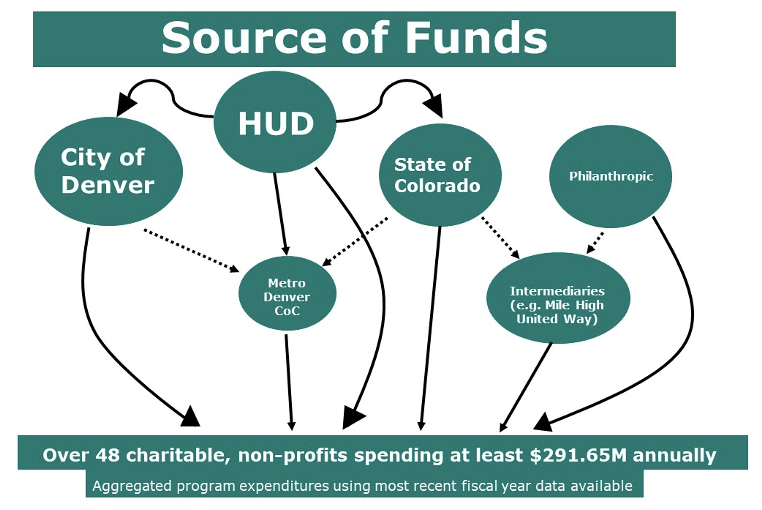
Note: The Metro Denver CoC (Continuum of Care) is currently the Metro Denver Homelessness Initiative (MDHI). As the CoC, MDHI coordinates housing and services funding for people experiencing homelessness.
Figure 8: Key Entities in the Homelessness Ecosystem
This is not a comprehensive list, but represent key entities in the ecosystem[xxi]
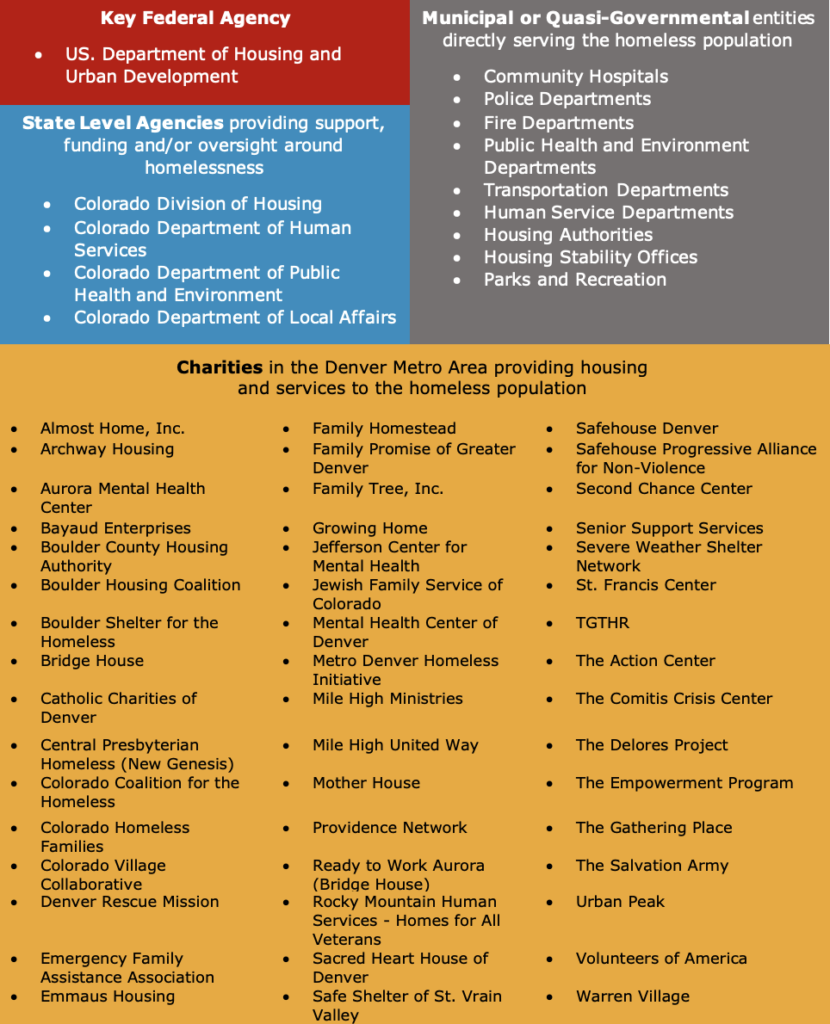
Federal Revenue Streams
In FY 2020, the HUD spent $2.777 billion on homelessness assistance programs across the country. From that amount, Colorado received a total of $98.3 million across three programs that provide significant support to people experiencing homelessness: the Continuum of Care (COC) program, the Emergency Solutions Grant (ESG) and the Housing Trust Fund (HTF). Of that total $98.3 million, $55.4 million was from the CARES Act to help communities address the impact of COVID-19. Other HUD programs, such as the Community Development Block Grant, focus on creating and supporting affordable housing, which often benefit individuals who have recently experienced homelessness or are housing insecure. The CDBG program also supports the development of homelessness facilities. In total, Colorado received $120.2 million in FY 2020 for affordable housing and community development programs. The analysis in this section focuses on the CoC, ESG and HTF homelessness assistance programs.
HUD Homelessness Assistance Programs[xxii]
- Continuum of Care (COC): The CoC program is designed to promote communitywide commitment to the goal of ending homelessness. The program provides funding for efforts by nonprofit providers, and state and local governments to quickly rehouse individuals and families experiencing homelessness, including funding for permanent housing, transitional housing, supportive services, HMIS, and, in some cases, homelessness prevention.[xxiii] The federal funding flows to a regional or local planning body that coordinates housing and services funding for families and individuals experiencing homelessness. These entities are responsible for collecting data around homelessness in their geographic reach.[xxiv]
- Emergency Solutions Grants (ESG) Program: The ESG program provides grants to states and localities for street outreach, emergency shelter, homelessness prevention, rapid re-housing assistance, and HMIS with the goal of assisting people to quickly regain stability in permanent housing after experiencing a housing crisis and/or homelessness.
- Housing Trust Fund (HTF): HTF provides grants to states for the construction, rehabilitation, and preservation of rental homes and for homeownership for extremely low- and very low-income families, including homeless families.
Figures 9 through 11 show awards made to cities, counties, providers and state agencies for the CoC, ESG and HTF programs. Note that the CARES Act COVID-19 federal relief package allocated $55.4M to the ESG program statewide in 2020; the amount without the CARES ACT funding for 2020 would have been $42.9 million.
Figure 9: HUD Homelessness Assistance Funding, Statewide

Source: U.S. Department of Housing and Urban Development, Awards and Allocations
* ESG 2020 funds include $55.4M in CARES Act allocations to the ESG program
Figure 10: HUD Homelessness Assistance Funding (ESG and CoC), Denver Metro Region, Adjusting for Inflation

Source: U.S. Department of Housing and Urban Development, Awards and Allocations
Figure 10 shows that ESG and CoC funding awarded to organizations and cities/counties in the Metro Denver region hovered around $30 million, adjusted for inflation, from 2015 to 2019. In 2020, the ESG program received an influx of funding through the CARES Act for COVID-19 response.
Figure 11 highlights the bigger recipients of federal HUD funding through the ESG and CoC programs over the past decade. Colorado Coalition for the Homeless received the largest portion of these federal funds, totaling $105.9 million over the 10 years. The cities of Denver, Boulder and Aurora collectively received $74.1 million over the last decade under these federal programs.
Figure 11: Metro Denver ESG and CoC Funding, 10 Year Totals

Source: U.S. Department of Housing and Urban Development, https://www.hudexchange.info/grantees/allocations-awards/
COVID-19 Federal Funding
Figures 9 through 11 include federal funding from the CARES Act that flowed through the 2020 HUD awards. The Metro Denver region also received a significant amount of funding through the 2021 American Rescue Plan Act (ARPA) that is intended to directly target homelessness.
The HOME Investment Partnerships Program, for example, received $29.4 million through ARPA for cities and counties in the Metro Denver region. According to HUD, these funds are intended to “help communities across the country create affordable housing and services for people experiencing or at risk of experiencing homelessness.”[xxv] Under the program, states have the flexibility to use the funding to best meet the needs of people experiencing or at risk of experiencing homelessness. Funds must be spent by 2030 on activities that could include new development of affordable housing, tenant-based rental assistance, supportive services, and acquisition and development of non-congregate shelter units.
Figure 12: 2021 American Rescue Plan Act HOME Investment Partnerships Program Allocations

Additionally, Governor Polis has dedicated $550 million to affordable housing from the federal ARPA funds that flowed to Colorado. It is expected some portion of this would go towards supporting people experiencing homelessness. Lastly, the state-funded Colorado Rescue Plan allocates $15 million to hotel rooms for unhoused individuals and $13 million in affordable housing projects incentives.[xxvi]
Estimated Expenditures Related to Homelessness
Introduction
Nearly half a billion dollars is spent annually on shelters, supportive services, health care and public assistance for individuals experiencing homelessness in the Metro Denver area. Within the city and county of Denver the figure approaches $447 million. These estimates are likely undercounting the full breadth of spending on this issue. The figures only include financial information that was available and do not capture the full array of charitable organizations, religious organizations, public agencies or health care and emergency responders that are dedicated to serving people experiencing homelessness. This analysis of annual expenditures includes only a partial list of municipal agencies engaged on this issue within Denver, Boulder or Aurora, and it does not include any city or county agencies in other areas of Metro Denver. While Denver Health costs are included, other regional and local hospital and health care costs are not included. For example, UCHealth provides a significant amount of uncompensated care to people experiencing homeless.
While these numbers are not precise, these estimates begin to shed light on the systemwide resources available to resolving homelessness. There is a growing demand on public resources and increasing scrutiny on public policy. An understanding of the existing resources – fiscal, human, and otherwise – can help launch a conversation about how the Metro Denver region can better connect individuals and families experiencing homelessness with stable housing and wraparound support.
This section begins with a look at three major cities in Metro Denver: City and County of Denver, City of Aurora, and City of Boulder. The numbers reported for these cities are not comprehensive, but this begins to illuminate the array of resources that municipalities are dedicating to homelessness. Following the city profiles is a section on the broader expenditures in the Metro Denver region and how those expenditures compare to other spending and expenses on a per person basis.
Further detail on the methodology of this section can be found in Appendix A.
City of Denver
The City of Denver provided data on agency spending from the police and fire departments, which have staff dedicated to supporting individuals experiencing homelessness (see Figure 13).
The City of Denver Police Department, for example, has an internal team to assist with efforts to resolve homelessness. The Homeless Outreach Team works with numerous city agencies and officials in an effort to keep both the housed and unhoused communities safe. Over the last year, the city itself has expanded specific programs to handle encampment enforcement so the police department is not solely responsible for every situation or complaint, especially when the complaint is not about criminal or unlawful behavior. The “Early Intervention Team”, which was initially designed to be a non-enforcement and outreach-focused team under the Department of Public Safety, is now transitioning to be under the Department of Public Health and Environment (DDPHE). The Early Intervention Team, along with the newly formed Street Enforcement Team, will handle general calls about encampments that get fielded through 311. The Street Enforcement Team, modeled from the park ranger system, will have a greater enforcement role through civilian members who will have the authority to issue citations for numerous violations. Offenses including unauthorized camping, trespassing, public urination, and obstruction of public passageways will all be enforced by this team.[xxvii]
Figure 13: Estimated Annual Expenditures, City of Denver

Source: Data provided to CSI from Denver Police and Fire Departments. Denver Health data found in 2020 Report to the City. Charitable organization spending collected from 990 Formsannual reports and outreach to organizations.
Other agencies, including DDPHE, the Department of Transportation and Infrastructure (DOTI), the Department of Human Services and the Department of Parks and Recreation, also provide services related to homelessness but those numbers were not available to include in this report. These agencies are investing in multiple initiatives that contribute to the City of Denver’s efforts on combatting homelessness. The Wellness Winnie is an example of one such initiative. As a mobile unit, the Wellness Winnie offers support, assistance, and resources by providing equitable access to behavioral health and support services.[xxviii] It is staffed with mental health counselors and peer navigators who provide essential supplies for daily living, offering information about resources, behavioral health screenings and assessments, and active referrals to services (medical, legal, social services, etc.). Wellness Winnie serves both housed and unhoused individuals. DOTI helps these efforts with their encampment clean-up programs through their Division of Solid Waste Management where they are responsible for the removal of all trash as well as the cleaning and sanitizing of the public space. DOTI also created a public restroom project where they have two restroom units, one mobile and one fixed, that allows all members of the community access to clean facilities.
Denver Health, which provides health care and emergency services to a significant portion of the homeless population, estimates in its annual report the cost of providing uncompensated care to individuals experiencing homelessness.[xxix] This amount, totaling $175.9 million in 2020, is included in Figure 15.
Figure 14: Recent City of Denver Tax Initiatives

The City of Denver has also recently passed two tax increases that support services and housing for the homeless population (see Figure 14). The Homelessness Resolution Fund, approved by voters in 2020, is intended to support housing, shelter and services for people experiencing homelessness. The Caring for Denver initiative, passed in 2018, allocates $36 million to the Caring for Denver Foundation, which is awarding grants to providers addressing mental health and substance abuse in Denver.[xxx] Some of the grants awarded by Caring for Denver are supporting organizations dedicated to serving individuals experiencing homelessness, such as The Gathering Place. However, the scope of the Caring for Denver tax revenue is much broader than solely serving the homeless population, and thus this revenue is not counted in Figure 13 or any of the totals in the report around expenditures on homelessness.
The other component of spending included in Figure 13 is the amount of spending by charitable organizations operating within Denver. The estimate of $216.4M includes spending by organizations in Denver that serve or house individuals experiencing homelessness. These organizations provide critical support including case management, shelters and housing, mental health support, rehabilitation services, and food and clothing. As stated above, this is not a precise accounting given the complexity of the ecosystem surrounding homelessness and likely underestimates the amount spent on service and housing for the homeless population. Because organizations have broader scopes of services than homelessness assistance, our numbers represent conservative estimates of what is being spent solely on people experiencing homelessness.
This report does not include expenditures by housing authorities dedicated to affordable housing. The federal Housing Choice Voucher program provided $220.1 million in funding to housing authorities located in the Metro Denver region in 2020.[xxxi] Of that, $90.4 million was spent by the Denver Housing Authority. A certain percentage of people served by the Housing Choice Voucher program self-identify as chronically homeless. One expert estimates the percentage to be around 30 percent, but that fluctuates depending on the area. Given the uncertainty around the amount being spent by housing authorities on housing for people experiencing homelessness, those amounts are not included, except for one grant for Boulder Housing Authority that was specifically awarded through HUD’s CoC program for rapid rehousing.
City of Boulder
In May 2021, the City of Boulder approved an 18-month budget of $2.7 million to implement three potential solutions to combat the current health and safety issues that are arising due to encampments and unhoused communities living in Boulder public spaces. Of this 18-month budget, about $1.03 million is allocated to be spent in the second half of 2021 and $1.63 million is allocated for 2022 calendar year expenditures.
Figure 15: Estimated Annual Expenditures, City of Boulder

*Estimated from approved 2022 city budget
Source: Boulder City Council Minutes from April 27, 2021 and May 11, 2021. Charitable organization spending collected from 990 Formsannual reports and outreach to organizations.
These city-wide proposals include an internal clean-up team and an integrated presence strategy (see Figure 15). Creating an internal clean-up team within the city’s utilities department will allow city officials to create a unified approach to supporting unhoused and housed community and maintain public spaces with a budget of $130,000 for 2022.[xxxii] To further assist with this maintenance and improve public safety, the city also proposed an increased presence of city ambassadors, park rangers, and Boulder Police officers. Approximately $372,000 will go towards an ambassador pilot program to generate an increased presence, maintenance, outreach, and education in the downtown and civic areas and include staff from several city departments. For 2022, $124,000 has been allocated to an urban ranger pilot program where rangers can serve as city-wide educators, officers, and medics providing functions as visitor services, protecting park resources, and enhancing use through education and enforcement. The final $1,002,644 would go towards increasing police presence during encampment cleanups happening throughout the city.
City of Aurora
The city of Aurora provided data from their Housing and Community Services Department that includes what is spent internally on homelessness related services and staff time expenditures in a given year. The city also provided estimates of expenditures from the police and fire departments. Neither of those departments tracks homelessness as a type of call for services, so these figures represent the departments’ best approximation for number, duration, and level of effort required to respond to calls for service for people experiencing homelessness.
Figure 16: Estimated Annual Expenditures, City of Aurora
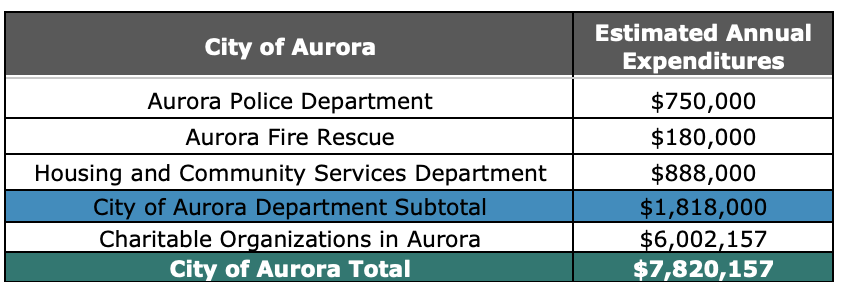
Source: Data provided to CSI from Aurora Police and Fire Departments and the Aurora’s Department of Housing and Community Services. Charitable organization spending collected from 990 Formsannual reports and outreach to organizations.
The Housing and Community Services Department expenditures do not include money that is delegated to non-profit organizations that also provide services to the local community. The expenditure estimate of $888,000 per year consists of $575,000 for the Aurora Flexible Housing Fund and $313,000 for staffing.
The Aurora Flexible Housing Fund is a program that benefits people being served by the Coalition of the Homeless’ services department. In Spring 2021, the city asked the community for input and ideas on alternative sheltering options to further serve people experiencing homelessness within Aurora. The city created a survey for community members to make comments on options including pallet homes, tents for safe camping, tiny homes, safe parking lots for those living out of vehicles, and restroom & shower trailers. The city is compiling survey responses and plans to work towards producing alternative and expansive programs and resources for people experiencing homelessness.
Metro Denver Expenditures
Figure 17 sums up the expenditures from our featured cities: Denver, Boulder and Aurora, and then adds in the remaining spending from charitable organizations in other cities and counties of Metro Denver. The bulk of the spending falls within the City of Denver for several reasons. First, Denver is home to many shelters and services for people experiencing homelessness, and, correspondingly, the city accounts for nearly 70 percent of the homeless population within the region. Second, this estimate includes Denver Health costs for providing health care to people experiencing homelessness, but there are not comparable numbers for other hospitals in surrounding cities and counting. UCHealth Anschutz Medical Campus, for example, is a major provider of care for the homeless population in Aurora, but they do not capture data on homelessness in their records. Third, the size of Denver relative to the size of other cities and counties means the city receives a greater share of federal funding, which in turn supports some of these expenditures.
Figure 17: Metro Denver Estimated Expenditures Related to Homelessness
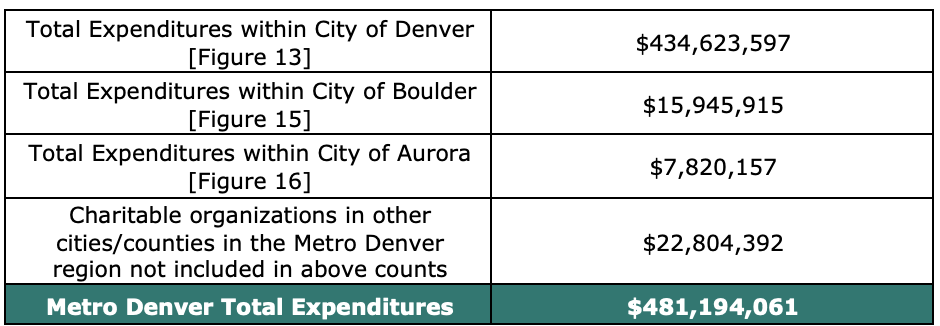
Note: Metro Denver includes seven counties: Adams, Arapahoe, Boulder, Broomfield, Denver, Douglas, and Jefferson. Charitable organization spending collected from 990 Formsannual reports and outreach to organizations.
The $481.2 million in spending within Metro Denver surpasses the size of some budgets for state level agencies, including the Departments of Natural Resources, Local Affairs and Labor and Employment.
Figure 18: Comparative Budgets for State Agencies

Figure 19 provides ranges of spending per individual experiencing homelessness using two different counts: the Point in Time (PIT) count and the annualized estimate which multiplies the PIT count by a factor of 2.5. This range provides a broad view of the amount of money spent annually within the City of Denver and within the wider 7-county region on shelters, services, and healthcare for individuals experiencing homelessness.
Figure 19: Spending on Homelessness Assistance per Person Experiencing Homelessness

Source: CSI Analysis
Within the City of Denver, the range of spending per person experiencing homelessness is $41,679 per person to $104,201 per person depending on the type of count used. In comparison, spending per pupil for K-12 education in Denver Public Schools is around $19,202.

[xxxiii][xxxiv][xxxv][xxxvi][xxxvii][xxxviii]
Workforce Serving People Experiencing Homelessness
The workforce serving people experiencing homelessness mirrors the complexity of the ecosystem. The workforce includes employees at charitable organizations, health care staff at local hospitals and urgent care centers, emergency responders, government workers, social workers, and counselors, among others. There is also a robust volunteer sector giving their time to this important issue. The following estimates were developed from an analysis of annual reports, 990 Forms, and interviews. Because some of the organizations offer a broader range of services than supporting the homeless population, precise numbers are difficult to obtain from available information. Instead, an estimated range of the workforce and volunteer sector is presented here.
In Metro Denver, it is estimated that 4,000 – 7,000 employees work in organizations, government agencies, emergency response units or other entities that have services or housing dedicated to people experiencing homelessness. The number of volunteers ranges from 55,000 – 85,000 people putting in around 200,000-300,000 hours. The financial value of volunteer hours is $5.7 – $8.6 million.
Figure 20: Workforce data
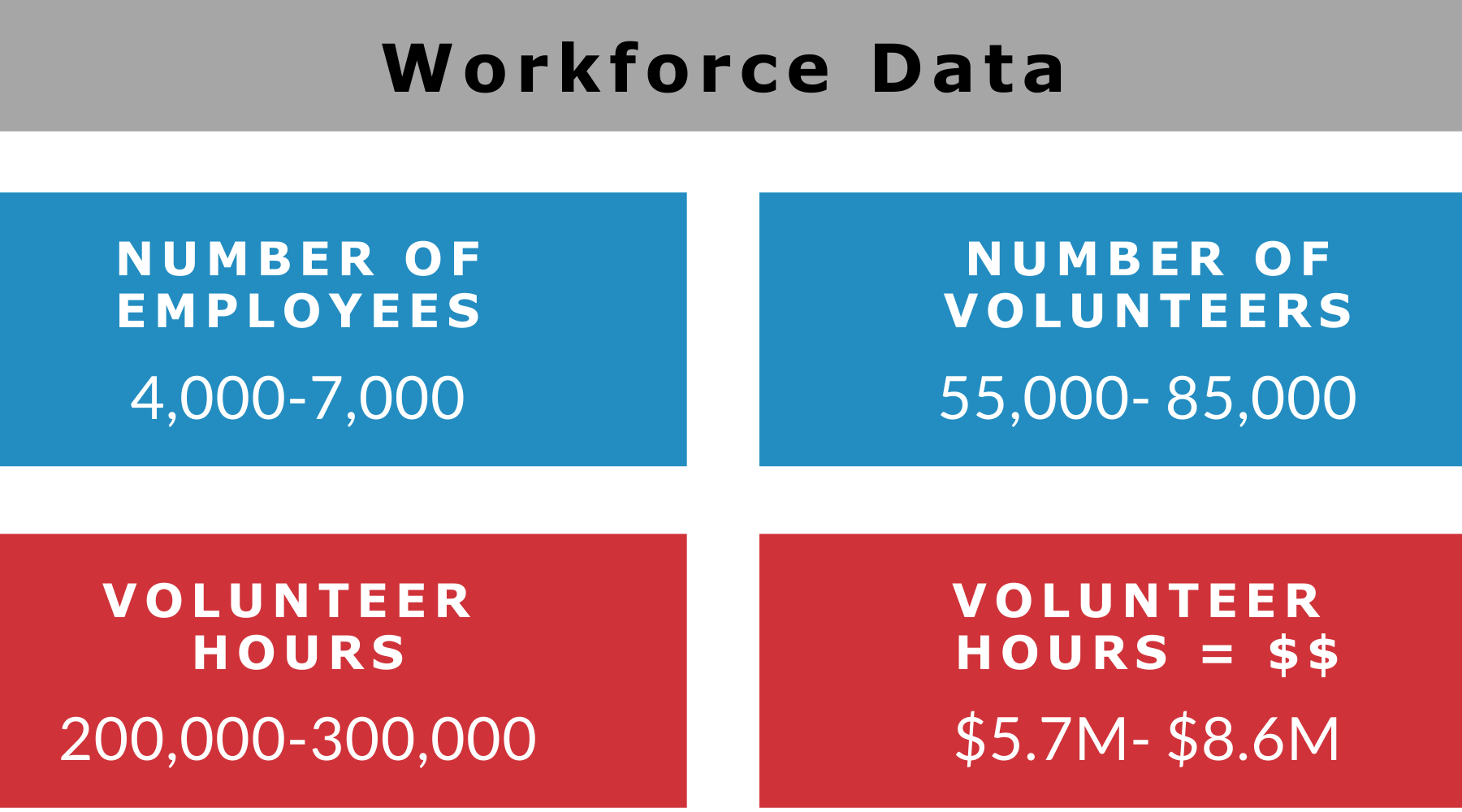
Source of Financial Value: Independent Sector
Number of Beds and Units for People Experiencing Homelessness
Over the past 10 years, the number of permanent supportive housing beds and emergency shelter beds have increased, while the number of transitional housing and rapid rehousing beds have decreased (see Figure 21).
Figure 21: Number of Beds by Type, Over Time

Source: U.S. Department of Housing and Urban Development; CoC Housing Inventory Count Reports.
Overall, both transitional housing and emergency shelters in Metro Denver had beds available during the 2020 Point in Time count (see Figure 22). Transitional housing was 72 percent occupied and emergencies shelters were 82% occupied if including the severe weather beds, or 88% occupied if severe weather beds are excluded.[xxxix] Data on bed occupancy for permanent supportive housing is not available for 2020, but in 2019, there were 3,167 total permanent supportive housing beds, of which 3,100 were occupied on the night of the PIT count, for an occupancy rate of 98 percent.[xl]
Figure 22: Bed Occupancy, 2020 Point in Time Count

Note: 264 of the available emergency shelter beds are for severe weather shelter only.
Source: MDHI, PIT Regional Report 2020
In Figure 22, 264 of the available emergency shelter beds are for severe weather use only. During extreme weather and emergencies, the City of Denver adapts to accommodate its unhoused population. As a city that experiences both extreme cold conditions in the winter and hot in the summer, Denver has elasticity in the number of shelter beds available. During these times, the city dispatches Early Intervention Teams who are responsible for contacting and communicating with the unsheltered community and encouraging them to move inside. As the Denver shelters fill to capacity during these severe weather situations, emergency centers are also created. In the past, facilities including The Lawrence Street Community Center and The Denver Coliseum were converted to shelters to withstand the influx of people experiencing homelessness and needing shelter.[xli]
Denver also greatly expanded the number of beds during the onset of the pandemic in spring 2020. Figure 23 displays data from the City of Denver’s Department of Housing Stability and shows the expansion of beds throughout the pandemic. This concerted effort meant supply kept pace with, and even exceeded, demand as the number of people experiencing homelessness increased during COVID-19.[xlii]
Figure 23: Homeless Shelter Capacity and Occupancy within City of Denver

Source: City of Denver, Department of Housing Stability, “COVID-19 Response Report,” March 2021, p 4. Note from City of Denver: “Shelter capacity and guest counts only include congregate shelters until April 19, 2020. Shelter capacity prior to the onset of the pandemic reflects the number of sleeping spaces facilities could typically accommodate.”
Conclusion
The Denver Metro region is investing a significant amount of funding – nearly half a billion dollars annually – to prevent and resolve homelessness. As the number of people experiencing homelessness continues to rise and as communities recover from COVID-19, now is a critical time to assess the ecosystem. This report attempts to understand the fiscal and human resources in the systems surrounding homelessness. The complexity of entities, funding streams and resources makes understanding the various and interconnected systems difficult. The data presented in this report provide a launching point for further inquiry.
The next phase of research in this project will identify factors within the ecosystem that have an outsized impact and will provide insights into where additional interventions and investments might address the root causes of persistent problems and accelerate the positive dynamics within the system. The goal of the forthcoming research will be to identify key areas for further investment that can maximize total impact and contribute to the resolution of homelessness in the Metro Denver area.
© 2021 Common Sense Institute.
Appendix A: Methodology & Data Notes
Methodology
- Focused on City of Denver and Denver Metro Area
- Using HUD definition of “Literal Homelessness”
- An individual or family who lacks a fixed, regular, and adequate nighttime residence, (i) Has a primary nighttime residence that is a public or private place not meant for human habitation; (ii) ls living in a publicly or privately operated shelter (including safe haven or transitional living program); or (iii) Is exiting an institution where (s)he has resided for 90 days or less and who resided in an emergency shelter or place not meant for human habitation immediately before entering that institution.
- Reporting “Program Services” expenditures from 990 Forms, the Secretary of State website, or from organizations who provided financial information to CSI. The estimates in this report do not count administrative or fundraising expenses.
- Financial data collected from charitable organizations is reported for FY 2020.
- For the purpose of grouping organizations by city for the analysis, we used the location of the organization’s headquarters. However, if an organization has headquarters in a city within Metro Denver but also operates outside of the Metro Denver region, we only counted expenditures within the region as described in the next section.
Data Notes
The homelessness industry consists of a network of charities and faith-based organizations who receive the bulk of their revenue through government contracts. Religious organizations are not required to file a Form 990. Some organizations were unwilling to participate in the data collection process for this report, including Metro Denver Homelessness Initiative (MDHI), which is the coordinating body for providers in the 7-county metro area.
The data from 990 forms do not break down expenditures by city or county. Four organizations included in our dataset provide services in areas outside of the Metro Denver region. Catholic Charities, Salvation Army and Volunteer of America provided specific data on expenditures within the Denver Metro area. For Colorado Coalition of the Homeless, we used the share of homeless individuals from the Point in Time count and applied that to an organization’s expenditures. Homeless individuals in Metro Denver comprise 61 percent of the state’s homeless population according to the Point in Time survey. Thus, we counted 61 percent of the statewide expenditures from Colorado Coalition of the Homeless in our reporting.
Several organizations have broad missions and provide a range of services beyond care and support for the literal homeless. We analyzed annual reports from organizations to identify which program spending to include. Rocky Mountain Human Services, for example, spent approximately $42.6 million in FY 2020 providing a wide array of services to individuals of all backgrounds. One of the programs the organization administers is called “Homes for All Veterans,” which is dedicated to ending Veteran homelessness. As a result, we only included the $3 million program budget for Homes for All Veterans in our reporting.
Appendix B: Glossary
Chronic Homelessness: HUD defines persons experiencing chronic homelessness as those who (a) are homeless, (b) are living in a place not meant for human habitation, in a safe haven, or in an emergency shelter, (c) have been homeless and living in a place not meant for human habitation, a safe haven, or an emergency shelter continuously for at least 1 year or on at least four separate occasions in the last 3 years where the combined length of time homeless across those occasions is at least 12 months, and (d) have a disability.
Continuum of Care (COC): A regional or local planning body that coordinates housing and services funding for homeless families and individuals. CoCs are responsible for collecting multiple data points around overall homelessness in their geographic reach.
Cumulative Count: Describes a methodology of counting that occurs continuously where people can be included in the count as soon as they are identified as homeless. The data provided generally represents a year time period.
Imminent Risk of Homelessness: An individual or family who will imminently lose their primary nighttime residence, provided that: (i) Residence will be lost within 14 days of the date of application for homeless assistance; (ii) No subsequent residence has been identified; and (iii) The individual or family lacks the resources or support networks needed to obtain other permanent housing.
Literal Homelessness (HUD Homelessness): An individual or family who lacks a fixed, regular, and adequate nighttime residence, meaning: (i) Has a primary nighttime residence that is a public or private place not meant for human habitation; (ii) Is living in a publicly or privately operated shelter designated to provide temporary living arrangements (including congregate shelters, transitional housing, and hotels and motels paid for by charitable organizations or by federal, state and local government programs); or (iii) Is exiting an institution where (s)he has resided for 90 days or less and who resided in an emergency shelter or place not meant for human habitation immediately before entering that institution.
Newly homeless: Newly homeless is defined as a person who has been experiencing homelessness for less than one year and this was their first episode of homelessness.
Point in Time (PIT): Describes a methodology of counting that occurs at a singular point in time, generally over the course of only a few days. The data presented only provides data on those that were identified as homeless during that point in time.
Rapid Re-Housing: An intervention designed to help individuals and families to quickly exit homelessness, return to housing in the community, and not become homeless again in the near term.
Safe Haven: A project that offers supportive housing that (1) serves hard to reach homeless persons with severe mental illness who came from the streets and have been unwilling or unable to participate in supportive services; (2) provides 24-hour residence for eligible persons for an unspecified period; (3) has an overnight capacity limited to 25 or fewer persons; and (4) provides low demand services and referrals for the residents.
Shelter: A project that offers temporary shelter (lodging) for the homeless in general or for specific populations of the homeless. In metro Denver, there are variations of shelter types, including family shelters where households may stay for 14- 90 days on average, and nightly shelter for individuals which may be nightly only or longer term depending on the program.
Transitional Housing: A project that provides temporary lodging and is designed to facilitate the movement of homeless individuals and families into permanent housing within a specified period of time, but typically no longer than 24 months. In transitional housing, there are generally higher eligibility and program requirements than in emergency shelter. Participants may be asked to pay rent or fees to stay in these programs.
Unsheltered (HUD Definition): With a primary nighttime residence that is a public or private place not designed for or ordinarily used as a regular sleeping accommodation for human beings, including a car, park, abandoned building, bus or train station, airport, or camping ground.
Glossary Sources: HUD, MDHI, National Alliance to End Homelessness
Appendix C: Letter from CU Denver Inworks
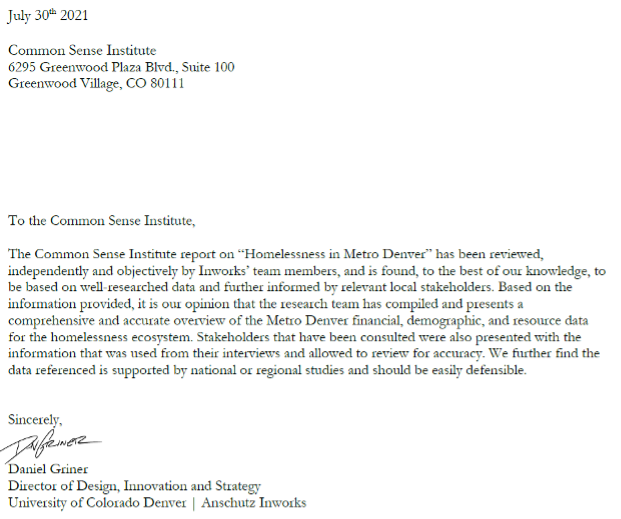
Appendix D: Community Partners
Thank you to our generous community partners:
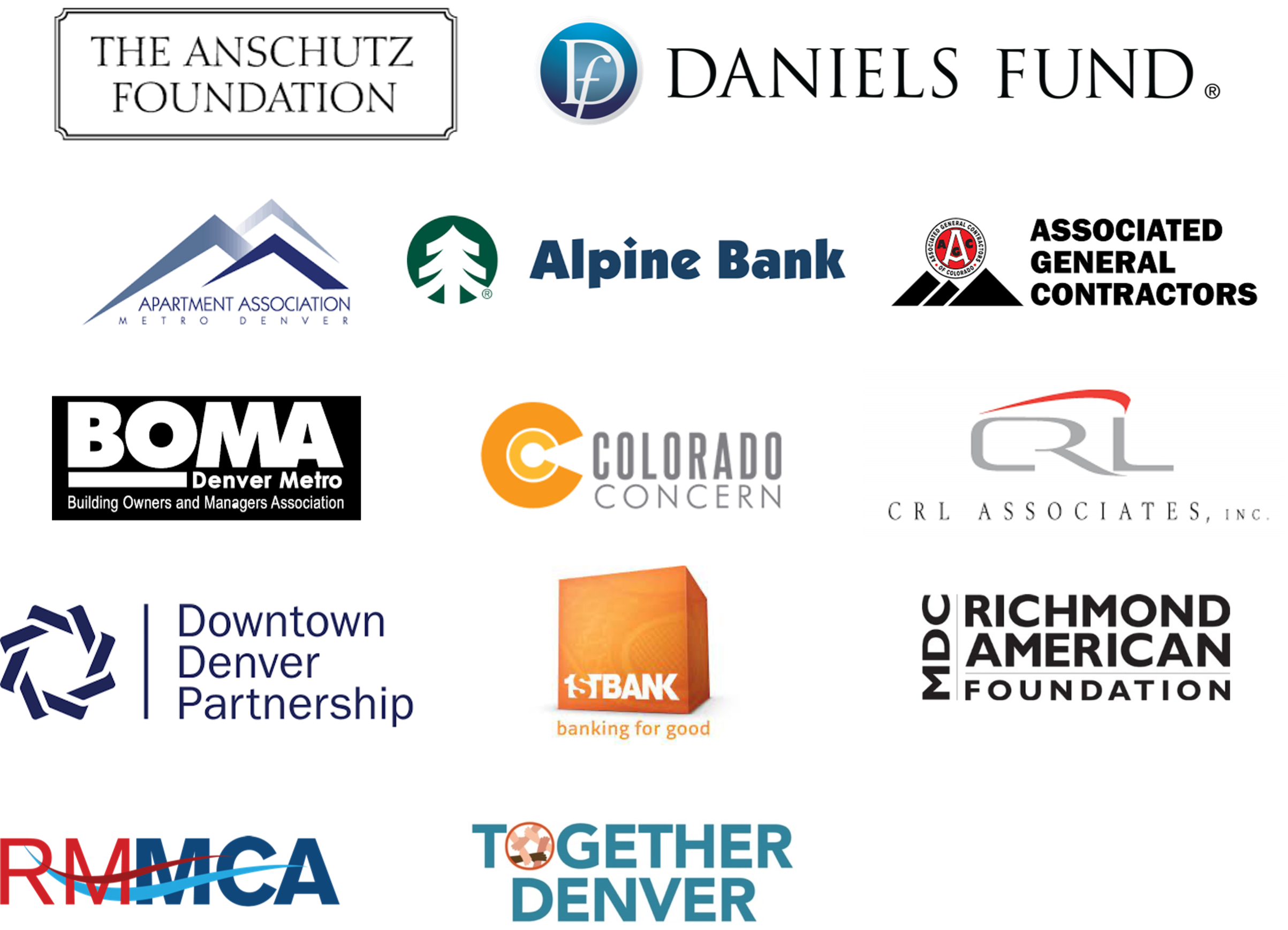
Appendix E: Endnotes
[i] MDHI, Metro Denver Homeless Initiative System Performance Assessment. Prepared by Focus Strategies, April 2018.
[ii] MDHI, PIT 2020 Dashboard.
[iii] City of Denver, Department of Housing Stability, “COVID-19 Response Report,” March 2021, p 4.
[iv] MDHI, PIT 2020 Dashboard.
[v] Ibid.
[vi] Ibid.
[vii] https://www.hud.gov/press/press_releases_media_advisories/HUD_No_21_055
[viii]Blair Miller & Benjamin Lloyd, “Deep Dive: Governor Polis announces distribution of money from American Rescue Plan Act.” KOAA News5, June 7, 2021.
[ix] Interview with City of Aurora, July 2021.
[x] Miller and Lloyd (2021).
[xi] Ibid.
[xii] MDHI, PIT Regional Report 2020.
[xiii] MDHI, 2019 Housing Inventory Count (HIC) Overview.
[xiv] City of Denver, Department of Housing Stability, “COVID-19 Response Report,” March 2021, p 4.
[xv] The seven counties are: Adams, Arapahoe, Boulder, Broomfield, Denver, Douglas, and Jefferson
[xvi] CoC Homeless Populations and Subpopulations Reports – HUD Exchange
[xvii] City of Denver, Department of Housing Stability, “COVID-19 Response Report,” March 2021.
[xviii] MDHI, PIT Regional Report 2020.
[xix] Ibid.
[xx] MDHI, State of Homelessness 2020.
[xxi] The charitable organizations listed have received CoC funds or local public funding at some point and have financial data that was available during the data collection period of this report.
[xxii] Program descriptions from HUD Exchange.
[xxiii] HUD Exchange, Continuum of Care (CoC) Program.
[xxiv] MDHI, State of Homelessness 2020 Report, 48.
[xxv] HUD Public Affairs, “Hud Announces $5 Billion To Increase Affordable Housing To Address Homelessness,” April 8, 2021.
[xxvi] Miller and Lloyd (2021).
[xxvii] Conor McCormick-Cavanagh, “Denver Setting Up Civil Enforcement Team for Homeless,” July 19, 2021.
[xxviii] City of Denver, “Wellness Winnie,” Accessed July 12, 2021.
[xxix] Denver Health, Report to the City 2020, 2020-report-to-the-city-digital-copy-final.pdf (denverhealth.org), p. 40.
[xxx] Caring for Denver Foundation
[xxxi] U.S. Department of Housing and Urban Development, Picture of Subsidized Households Database, Accessed July 23, 2021.
[xxxii] This report is estimating expenditures that occur over the course of one year. Thus, the 2022 City of Boulder budget numbers are being counted in the total expenditure amounts to account for a full year of spending.
[xxxiii] The Denver Crime Prevention and Control Commission has estimated that Denver spends upwards of $7.3 million per year on 250 chronically homeless individuals who frequently interact with the city’s jail, detox and healthcare systems. This amounts to $29,200 per individual.
[xxxiv] Urban Institute, “Housing First Breaks the Homelessness-Jail Cycle,” July 15, 2021.
[xxxv] CSI calculation from financial data provided by the Colorado Department of Education.
[xxxvi] Average Rent Market Trends, Rentcafe.com
[xxxvii] U.S. Census, Denver County, Colorado.
[xxxviii] U.S. Census, Denver County, Colorado
[xxxix] MDHI, PIT Regional Report 2020
[xl] MDHI, 2019 Housing Inventory Count (HIC) Overview.
[xli] Extremely cold weather in Denver area will endanger the homeless this weekend. (denverpost.com)
[xlii] City of Denver, Department of Housing Stability, “COVID-19 Response Report,” March 2021, p 4.

